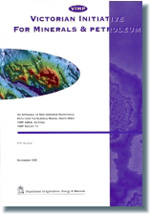VIMP Report 14 - An appraisal of new airborne geophysical data over the Glenelg region, north west VIMP area, Victoria
 |
| |||||||||||||||||||||||||||||||||||||||||||
Product description:Download The downloadable version of this report is supplied in PDF format. Abstract Detailed geophysical airborne surveys were flown in western Victoria during 1994 and 1995 for the Geological Survey of Victoria, as part of the Victorian Initiative for Minerals and Petroleum North West Initiative project. The magnetic data reflect a complex geological setting, comprising moderate to intense magnetic and non magnetic intrusives and extrusives, non magnetic sediments and magnetic drainage patterns and strand lines. A number of these features are cut, or bound by, linear magnetic, non magnetic or crosscutting trends related to the structural character of the area. The magnetic data show the dominant structural direction, in common with other parts of Victoria, to be northwest to north-northwest. Numerous lineaments and faults accompanied by dykes, reflect the strong deformation which has influenced the Glenelg region. Metasediments and sediments are typically non magnetic, and units cannot be distinguished from one another. In the southwest of the Glenelg region, multiple, moderate to intense, curvilinear, discontinuous magnetic features with a northwest trend are associated with thin belts of near surface greenstones. Significant variations in magnetic properties of granitic intrusions are apparent, and may aid in mapping and classifying these bodies. Major discrepancies between the mapped geology of the Harrow, Chetwynd River and Dergholm granites are indicated from interpreted boundaries from the magnetic data. Many intrusions display northwest, north-northwest, north-northeast, northeast and east-northeast lineations represented typically by magnetic lows. These lineations maybe be due to faults, joints or quartz veining within the intrusions. The Rocklands Rhyolite has a variable magnetic response. The magnetic data can be related to different flows. Small high frequency magnetic responses scattered throughout the Glenelg region, interpreted to be Tertiary basalts, are represented by plugs and lava flows. In the west, radiometric data have weak responses, compared to the south and east which is dominated by high potassium and thorium responses. Drainage channels show high potassium, reflecting the wide distribution of granitic intrusions in the region. Granitic intrusives, volcanic extrusives, trachyte and rhyolite vary in potassium response. High thorium responses reflects laterite that caps most of the land surface in the east. Quaternary Malanganee Sands show a distinct low radiometric signature. The Glenelg region offers opportunities for the exploration of base metal, gold, diamond, mineral sand and coal deposits. Bibliographic reference Slater, K.R., 1995. An appraisal of new airborne geophysical data over the Glenelg region, North West VIMP area, Victoria. Victorian Initiative for Minerals and Petroleum Report 14. Department of Agriculture, Energy and Minerals. Related products:
| ||||||||||||||||||||||||||||||||||||||||||||




